Ken Carl's Book – Deeply Rooted
Search Flickr By Color With MultiColr Search Lab
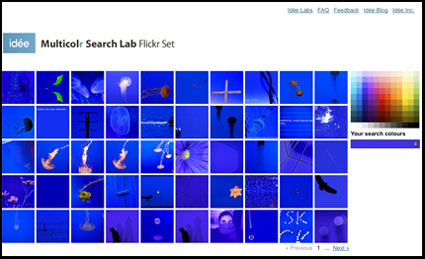 Idee’s MultiColr Search Lab lets you search over 10 million Creative Commons images on Flickr by color using their visual similarity technology.
Idee’s MultiColr Search Lab lets you search over 10 million Creative Commons images on Flickr by color using their visual similarity technology.
Learn more in this video. Then try it!
NAPP Exclusive Webcast Today 3-4 PM
NAPP members can enjoy a free exclusive webcast today.
Friday, July 9, 2010 from 3:00 – 4:00 PM EST.
Plus you’ll also find 3 free videos from their June 25 NYC CS5 Summit.
Log in to the NAPP members website here.
Where to Put ICC Profiles
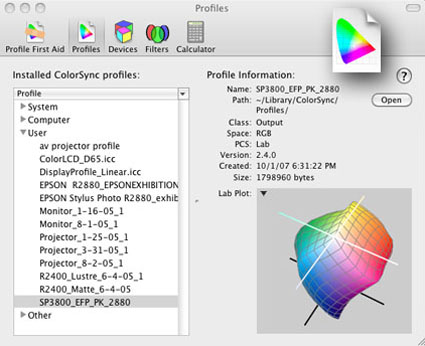
ICC profiles need to be filed in the correct location on your computer for them to be available to applications.
Where do you put them? It depends on the system and version you’re using.
Mac OS X
– Library / ColorSync / Profiles – storing profiles here allows all Users to use them.
– Users(Username) / Library / ColorSync / Profiles – storing profiles here makes them available to the current user only .
Windows 7, Vista and XP
– Windows \ System32 \ Spool \ Drivers \ Color
– Right click on the profile and select “Install Profile” to copy the profile to the directory.
– Profiles need to be copied manually to the directory to replace profiles.
Mac OS 9.x
– System / ColorSync / Profiles
Windows 2000 and NT
– Winnt \ System32 \ Spool \ Drivers \ Color
– Right click on the profile and select “Install Profile” to copy the profile to the directory.
– Profiles need to be copied manually to the directory to replace profiles.
Windows ME and 98
– Windows \ System \ Color
Apple’s ColorSync Utility displays details of individual profiles, shows gamut plots, can rename profiles, validates profile structure, etc.
Microsoft’s has a Control Panel Applet installs and removes profiles, edits internal and external names, creates 3-D gamut plots, compares profiles, etc.
Read more on Color Management here.
Learn more in my digital photography and digital printing workshops.
See Namibia By Air
Enjoy a bird’s eye view whenever you can.
We’ve arranged extra time in the air for my upcoming Namibia workshop.
The views of the desert and coastline are truly extraordinary from the air.
Explore Namibia with Google Earth and you’ll quickly see how fantastic it is.
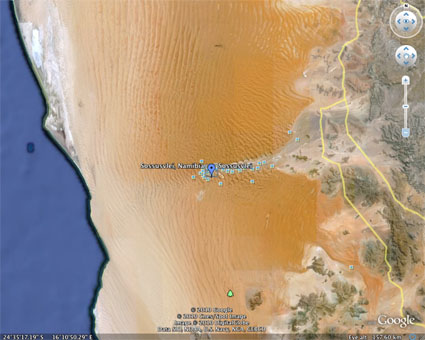

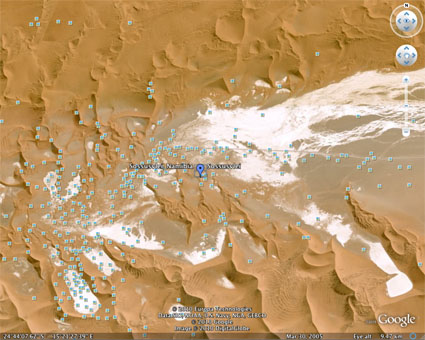
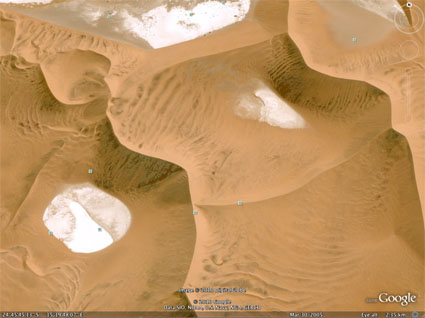
Find out more about my Namibia workshop here.
Tag Galaxy – Search Flickr Visually
Tag Galaxy offers an interactive way to search Flickr visually.
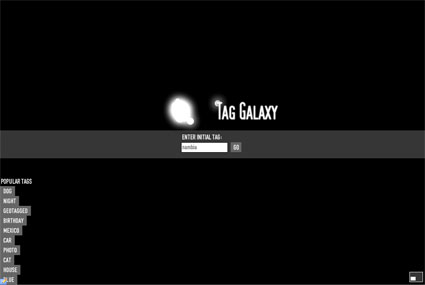
1 Type a tag and a galaxy of related tags will appear as orbiting planets.
 2 Click on a planet and images will be assembled in an interactive orb.
2 Click on a planet and images will be assembled in an interactive orb.
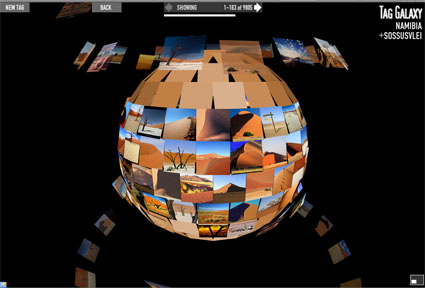 3 Click on an image to see the whole image with title.
3 Click on an image to see the whole image with title.
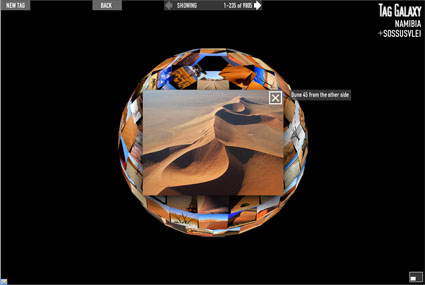 4 Click again on the image to learn detailed information about it.
4 Click again on the image to learn detailed information about it.
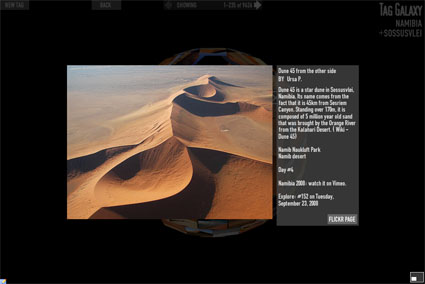 5 Click Flickr Page to go to the source file and see comments and more.
5 Click Flickr Page to go to the source file and see comments and more.
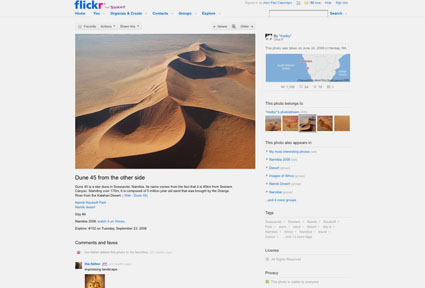
Visually find images on Flickr and connections between them with Tag Galaxy.
Try it now!
See my Namibia and Antarctica galleries on Flickr here.
Stay tuned for more.
Blurb's Return Policy
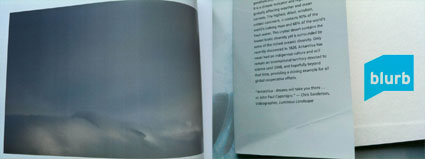
If your Blurb book was damaged in shipping or has a production defect (like banding or improper binding) Blurb will replace it. Simple email them a picture of your problem to start the process.
There are a number of things that can go wrong that Blurb can’t cover, which you can control by carefully checking a file before you upload it.
Here’s Blurb’s Return Policy.
Blurb guarantees your satisfaction with the workmanship of your book. On the off chance your book arrives damaged or with a manufacturing defect, contact us via Blurb’s Customer Support within 14 days of receipt. We’ll make things right. Please understand that Blurb does not provide refunds or cancel orders, and except for the cases expressly described in this return policy (i.e., your book arrives damaged, with a manufacturing defect or a defect in workmanship), Blurb cannot otherwise accept returns.
Please note that each book you order from us is individually made by one of Blurb’s top-notch professional book-printing partners. There may be minor differences across different prints of the same books and/or across books printed by our different book-printing partners, including, but not limited to, slight variances in color fidelity and binding type. While we work very hard to keep our product as consistent as possible, this variation is a normal occurrence and is not considered a manufacturing defect or a defect in workmanship and does not qualify for a reprint.
When Purchasing Your Own Book…
Your book is all yours: Blurb does not proof, edit, or change your content in any way. This means it’s your responsibility to review your book before you publish, and fix:
– Typos, grammar, unfinished text, or other text errors
– Low-resolution images that may appear blurry in print
– Dark images that appear dark on screen (Blurb doesn’t lighten your images to match what you see on a backlit screen)
– Design issues, including book format, organization, style, color, and page layout
– Any other creative choices you made in Blurb BookSmart® or PDF to Book you want to revisit
We strongly recommend printing a hard copy of your book on your local printer for a final once-over. (You might ask a friend to look it over, too.) If you find changes you’d like to make, no problem. Just make them in Blurb BookSmart® or your original PDF to Book file, upload the revised book, and then order as many copies as you’d like.
When Purchasing a Book From the Blurb Bookstore…
Blurb is not responsible for the quality of the content of any book in the Blurb Bookstore. Each book you purchase from the Blurb Bookstore is custom printed only upon your order, and we don’t warehouse books, therefore we do not accept returns or process refunds for any reason, except to the extent we guarantee your satisfaction with the workmanship of our books, as described above.
Learn more with my Bookmaking Lessons.
Learn more in my Fine Art Digital Printing Workshops.
Get Great Color in Blurb Books!

X-Rite and Joe Brady offer this free 52 minute webinar on how to get great color in Blurb books.
![]() Step-by-Step Guide to Creating Your Book (37 Minutes)
Step-by-Step Guide to Creating Your Book (37 Minutes)
Learn how to: create your book; work with photos, text, and layouts; upload your book; and more.
![]() Blurb BookSmart® Design Tips and Techniques (26 minutes)
Blurb BookSmart® Design Tips and Techniques (26 minutes)
For those who already know the basics of BookSmart, this intermediate session explores several design ideas you can use in your books.
![]() Using InDesign® to Make a Blurb Book (3:33)
Using InDesign® to Make a Blurb Book (3:33)
A short three-minute introduction to using Adobe InDesign® to create compliant PDF files by using the Blurb PDF/X-3 Export Preset and the Blurb Templates.
Learn more with my Bookmaking Lessons.
Learn more in my Fine Art Digital Printing Workshops.


